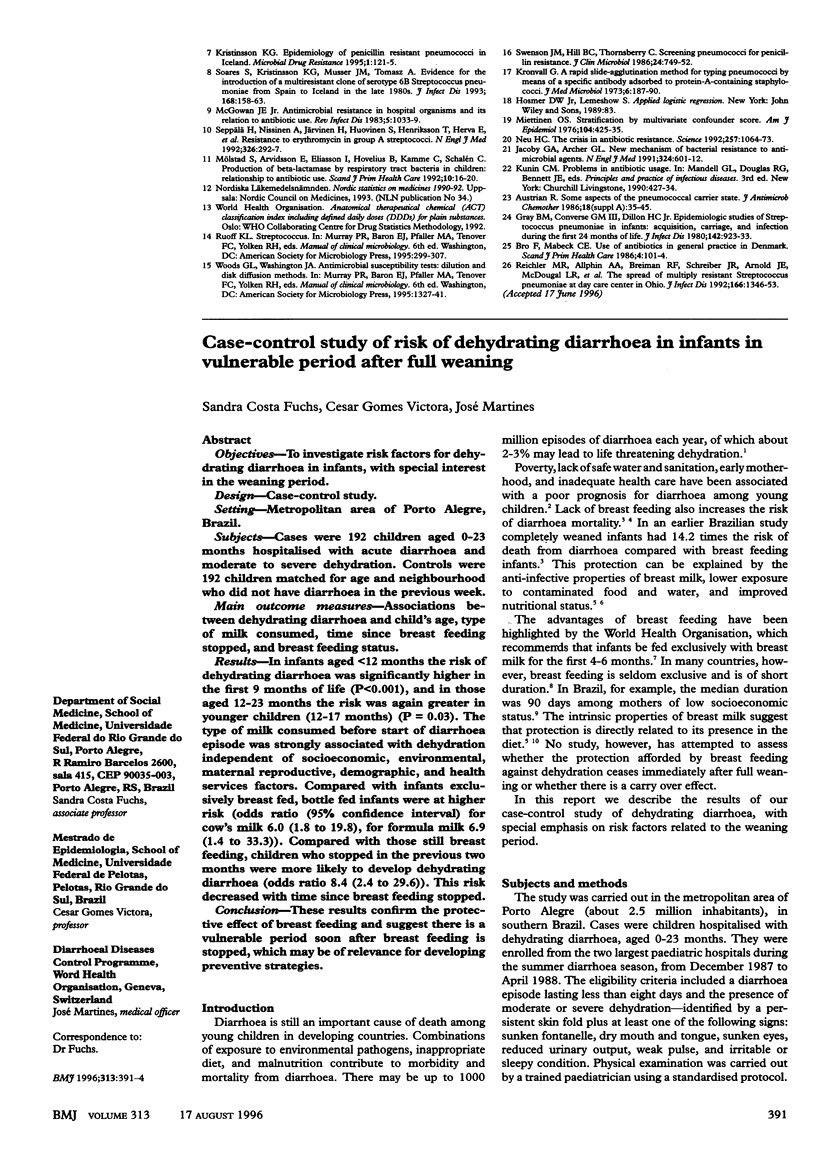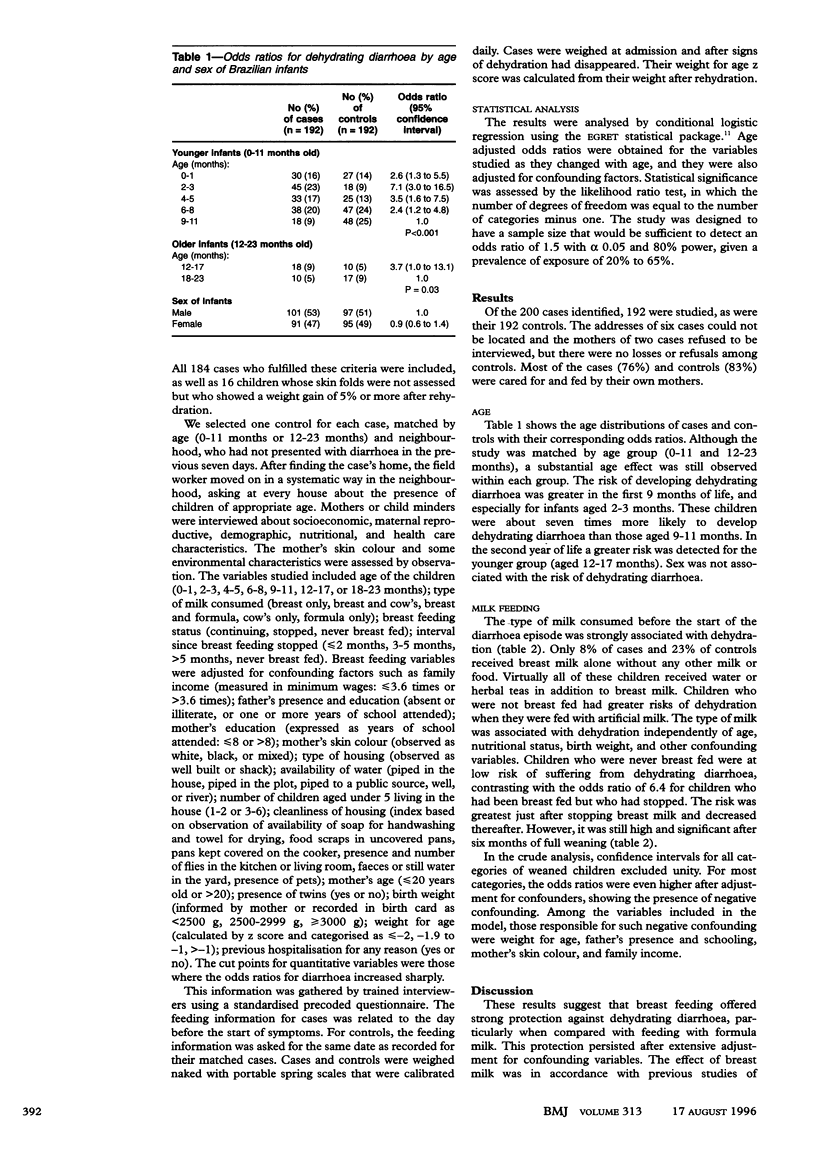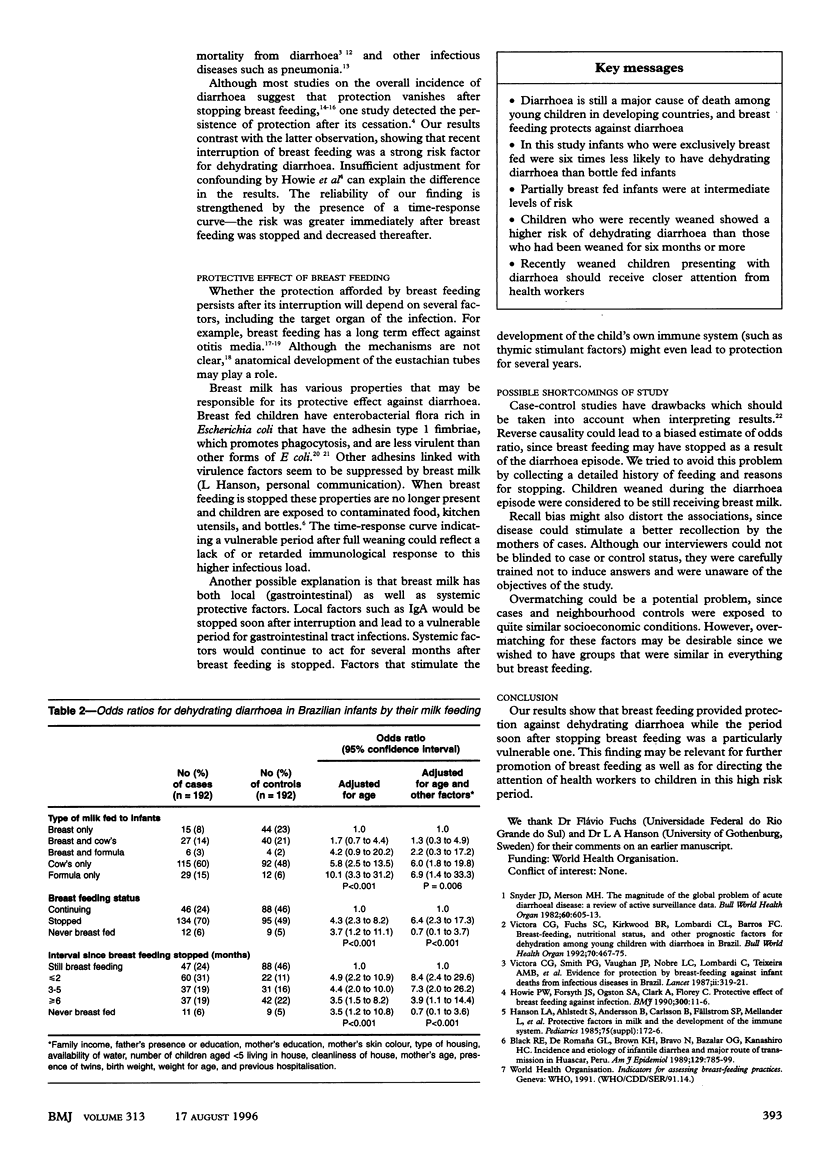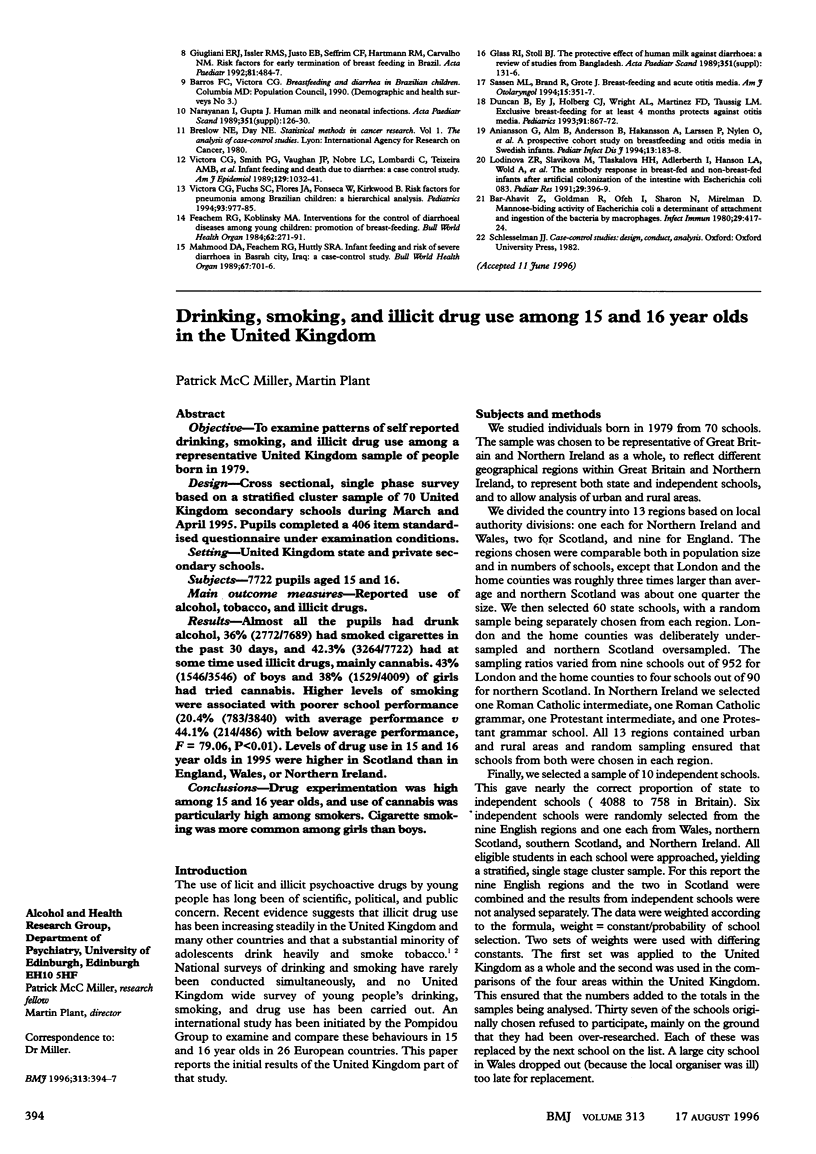Abstract
OBJECTIVES: To investigate risk factors for dehydrating diarrhoea in infants, with special interest in the weaning period. DESIGN: Case-control study. SETTING: Metropolitan area of Porto Alegre, Brazil. SUBJECTS: Cases were 192 children aged 0-23 months hospitalised with acute diarrhoea and moderate to severe dehydration. Controls were 192 children matched for age and neighbourhood who did not have diarrhoea in the previous week. MAIN OUTCOME MEASURES: Associations between dehydrating diarrhoea and child's age, type of milk consumed, time since breast feeding stopped, and breast feeding status. RESULTS: In infants aged < 12 months the risk of dehydrating diarrhoea was significantly higher in the first 9 months of life (P < 0.001), and in those aged 12-23 months the risk was again greater in younger children (12-17 months) (P = 0.03). The type of milk consumed before start of diarrhoea episode was strongly associated with dehydration independent of socioeconomic, environmental, maternal reproductive, demographic, and health services factors. Compared with infants exclusively breast fed, bottle fed infants were at higher risk (odds ratio (95% confidence interval) for cow's milk 6.0 (1.8 to 19.8), for formula milk 6.9 (1.4 to 33.3)). Compared with those still breast feeding, children who stopped in the previous two months were more likely to develop dehydrating diarrhoea (odds ratio 8.4 (2.4 to 29.6)). This risk decreased with time since breast feeding stopped. CONCLUSION: These results confirm the protective effect of breast feeding and suggest there is a vulnerable period soon after breast feeding is stopped, which may be of relevance for developing preventive strategies.
Full text
PDF



Selected References
These references are in PubMed. This may not be the complete list of references from this article.
- Aniansson G., Alm B., Andersson B., Håkansson A., Larsson P., Nylén O., Peterson H., Rignér P., Svanborg M., Sabharwal H. A prospective cohort study on breast-feeding and otitis media in Swedish infants. Pediatr Infect Dis J. 1994 Mar;13(3):183–188. doi: 10.1097/00006454-199403000-00003. [DOI] [PubMed] [Google Scholar]
- Bar-Shavit Z., Goldman R., Ofek I., Sharon N., Mirelman D. Mannose-binding activity of Escherichia coli: a determinant of attachment and ingestion of the bacteria by macrophages. Infect Immun. 1980 Aug;29(2):417–424. doi: 10.1128/iai.29.2.417-424.1980. [DOI] [PMC free article] [PubMed] [Google Scholar]
- Black R. E., Lopez de Romaña G., Brown K. H., Bravo N., Bazalar O. G., Kanashiro H. C. Incidence and etiology of infantile diarrhea and major routes of transmission in Huascar, Peru. Am J Epidemiol. 1989 Apr;129(4):785–799. doi: 10.1093/oxfordjournals.aje.a115193. [DOI] [PubMed] [Google Scholar]
- Duncan B., Ey J., Holberg C. J., Wright A. L., Martinez F. D., Taussig L. M. Exclusive breast-feeding for at least 4 months protects against otitis media. Pediatrics. 1993 May;91(5):867–872. [PubMed] [Google Scholar]
- Feachem R. G., Koblinsky M. A. Interventions for the control of diarrhoeal diseases among young children: promotion of breast-feeding. Bull World Health Organ. 1984;62(2):271–291. [PMC free article] [PubMed] [Google Scholar]
- Giugliani E. R., Issler R. M., Justo E. B., Seffrin C. F., Hartmann R. M., Carvalho N. M. Risk factors for early termination of breast feeding in Brazil. Acta Paediatr. 1992 Jun-Jul;81(6-7):484–487. doi: 10.1111/j.1651-2227.1992.tb12279.x. [DOI] [PubMed] [Google Scholar]
- Glass R. I., Stoll B. J. The protective effect of human milk against diarrhea. A review of studies from Bangladesh. Acta Paediatr Scand Suppl. 1989;351:131–136. doi: 10.1111/j.1651-2227.1989.tb11225.x. [DOI] [PubMed] [Google Scholar]
- Hanson L. A., Ahlstedt S., Andersson B., Carlsson B., Fällström S. P., Mellander L., Porras O., Söderström T., Edén C. S. Protective factors in milk and the development of the immune system. Pediatrics. 1985 Jan;75(1 Pt 2):172–176. [PubMed] [Google Scholar]
- Howie P. W., Forsyth J. S., Ogston S. A., Clark A., Florey C. D. Protective effect of breast feeding against infection. BMJ. 1990 Jan 6;300(6716):11–16. doi: 10.1136/bmj.300.6716.11. [DOI] [PMC free article] [PubMed] [Google Scholar]
- Lodinová-Zádníková R., Slavíková M., Tlaskalová-Hogenová H., Adlerberth I., Hanson L. A., Wold A., Carlsson B., Svanborg C., Mellander L. The antibody response in breast-fed and non-breast-fed infants after artificial colonization of the intestine with Escherichia coli O83. Pediatr Res. 1991 Apr;29(4 Pt 1):396–399. doi: 10.1203/00006450-199104000-00013. [DOI] [PubMed] [Google Scholar]
- Mahmood D. A., Feachem R. G., Huttly S. R. Infant feeding and risk of severe diarrhoea in Basrah city, Iraq: a case-control study. Bull World Health Organ. 1989;67(6):701–706. [PMC free article] [PubMed] [Google Scholar]
- Narayanan I., Gupta J. Human milk and neonatal infections. Acta Paediatr Scand Suppl. 1989;351:126–130. doi: 10.1111/j.1651-2227.1989.tb11224.x. [DOI] [PubMed] [Google Scholar]
- Sassen M. L., Brand R., Grote J. J. Breast-feeding and acute otitis media. Am J Otolaryngol. 1994 Sep-Oct;15(5):351–357. doi: 10.1016/0196-0709(94)90134-1. [DOI] [PubMed] [Google Scholar]
- Snyder J. D., Merson M. H. The magnitude of the global problem of acute diarrhoeal disease: a review of active surveillance data. Bull World Health Organ. 1982;60(4):605–613. [PMC free article] [PubMed] [Google Scholar]
- Victora C. G., Fuchs S. C., Flores J. A., Fonseca W., Kirkwood B. Risk factors for pneumonia among children in a Brazilian metropolitan area. Pediatrics. 1994 Jun;93(6 Pt 1):977–985. [PubMed] [Google Scholar]
- Victora C. G., Fuchs S. C., Kirkwood B. R., Lombardi C., Barros F. C. Breast-feeding, nutritional status, and other prognostic factors for dehydration among young children with diarrhoea in Brazil. Bull World Health Organ. 1992;70(4):467–475. [PMC free article] [PubMed] [Google Scholar]
- Victora C. G., Smith P. G., Vaughan J. P., Nobre L. C., Lombardi C., Teixeira A. M., Fuchs S. C., Moreira L. B., Gigante L. P., Barros F. C. Infant feeding and deaths due to diarrhea. A case-control study. Am J Epidemiol. 1989 May;129(5):1032–1041. doi: 10.1093/oxfordjournals.aje.a115207. [DOI] [PubMed] [Google Scholar]


